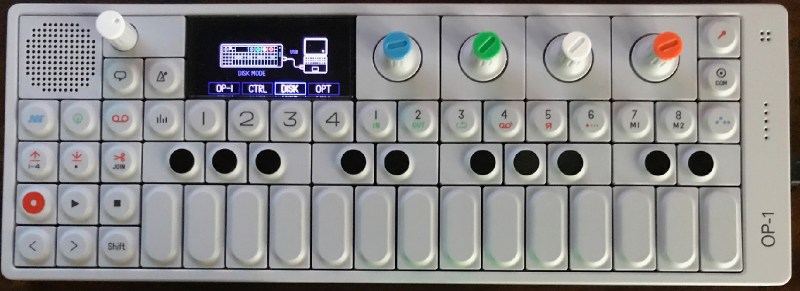The Teenage Engineering OP-1 is a tiny, portable synthesizer loaded up with 4-track recording, a sampler, sequencers, and a quite good synthesis engine. It also fits in your pocket and looks like a calculator built in West Germany. As you would expect with a synth/sampler/sequencer, you can save sounds, tracks, and other creations to a computer. [Doug] thought if you can connect it to a laptop, you can also connect it to a Raspberry Pi. He created an all-in-one storage solution for the OP-1 using only a Pi and a small character LCD.
The process of connecting the Pi to the OP-1 is pretty simple. First, plug a USB cable into the OP-1 and the Pi. Then, place the OP-1 into Disk Mode, the synth’s method of transferring files between itself and a computer. The Pi then synchronizes, changes the color of its character display from red to green, and becomes a web server available over WiFi where all the files can be accessed.
This is the bare minimum tech required to get files into and off of the OP-1. All you need is a bit of power and a USB connection, and all the files on the OP-1 can be backed up, transferred, or replaced without any other futzing around. It’s perfect for the minimalist OP-1, and a great example of how handy a WiFi enabled Pi can be.
Thanks [Pator] for sending this one in.
















“looks like a calculator built in West Germany”
which one exactly ? or did you mean built in east Germany ?
whatever that means… :(
Because TI calculators used to look good… no they didn’t, and they still look ugly. Some HP models looked really good like the HP-41C(V/X) and the HP-71B, the best being the HP-75, imho :)
That synthesizer looks beautiful and robust.
Looks beautiful and robust, but unfortunately is also surprisingly expensive…
Functional or Attractive just like people look how that’s turned out in workplaces.
Since it seems to bother you greatly: http://www.unisonhome.com/braun-white-calculator.html
Probably a reference to old Siemens keyboards http://imgur.com/gallery/3sMW2
Oh dear!! … those Olivetti 1980’sh looking keys !!!!
Beautiful!
Like this? http://www.vintagecalculators.com/assets/images/OlivettiLogos43PD_1.jpg
The lady and the tramp
In other news why is HAD not covering pines
ROCK 64
https://www.pine64.org/?page_id=7147
EMMC support and USB 3
Sexy beast
Wow! the Pine is still around!
They don’t really cover the BBB or Odroids either. No one does. It’s the Pi or the Pi.
Like VHS, the PI won because of adoption. What drove adoption of the RPi was price and the support. Without the price you would not have got the support. Without the support it would not have won.
The RPi won, get over it.
There were a lot of factors that decided the Pi’s success. Price, release date, availability, eduction system, community support, media attention, etc. Of course having major partners to spoon feed them marketshare early on (Farnell, RS components, Microcenter, Adafruit, etc.) and provide hardware and software development (Broadcom) probably helped more than anything. The only other board that received even a fraction of that support was the Beaglebone, which has actually sold over a million units. Not bad. Everyone else has been going it pretty much alone. Unfortunately life is rough when you make a board the community won’t even look at because they don’t even know your board exists because sites like Hackaday or Make or Adafruit totally ignore you.
thank you for making me discover that thing, really impressive
4GB 1600MHz LPDDR3, USB3, Gigagit ethernet, 4Kvideo
Now we can play !
Does it really exist ?
no, and neither will drivers/support when it actually ships in a year
ooOO how did i not no about that!, i’ve been looking at odroid and ‘nana pi’s. this is great!
arrrgh my spelling. such shame.
Teenage engineering – getting the clasp on a bra strap undone.
Out of seven articles appearing today in my Hackaday feed, three are based on the Rasbperry Pi. Anybody remember the “too much Arduino” complaints from a few years ago? Just an observation. Oh. And the project is cute.
Nope, but I do think we have a lack of Benchoff recently.
I love Teenage Engineering. I’ve been dying to get an OP-1 since it came out, but sadly it’s been too long since I had that kind of disposable money.